The National Gallery’s haunting new exhibition The Last Caravaggio has at its heart a sepulchrally toned painting called The Martyrdom of Saint Ursula. Caravaggio includes himself in it as a witness to a brutal murder – a pale, bleak farewell of a self-portrait set against Stygian darkness. An extravagantly armoured man, the chief of the Huns, has been rejected by the beautiful young Ursula. His response is to shoot her with an arrow at point blank range. She contemplates the shaft between her breasts as if she can’t believe what she is seeing: her own death.
Soon after painting this, Caravaggio too would be dead. Sailing north from the Naples area to Rome in the heat of summer in a triangular-sailed felucca, he was arrested at a coastal stop and by the time he was released his luggage, including new paintings, had left without him. He seems to have run or hitched a ride along the coast to catch up with it and probably caught malaria. He was 38 when he died at Porto Ercole in southern Tuscany on 18 July 1610.
Who killed Caravaggio? While the prime suspect is the malaria-carrying Anopheles mosquito, mystery surrounds his end. In the months before his fatal journey he was in a desperate, wounded state – and on the run. He had recently moved nervously across Sicily, fearing he was being followed, painting a handful of religious masterpieces in Syracuse, Messina and Palermo but resting nowhere. He then sailed for Naples where his agitation was quickly proven justified.

A group of men attacked Caravaggio outside an inn in Naples and left him so badly hacked about the face he was “unrecognisable”, says a 17th-century biography. It was not a random attack. The assailants were looking for him and may have followed him, as he feared, through Sicily.
One of his near-contemporary biographers, Giovanni Pietro Bellori, is frank about who sent the attackers. Caravaggio was being hounded by the Knights of Saint John, a religious military order that he had recently tried to join on its stronghold, Malta. He fled to Naples because he felt unsafe, “and hoping to placate the Grand Master, Caravaggio sent to him as a present a half-figure of Herodias with the head of John the Baptist”. This Grand Master of the Order of Saint John was a French nobleman called Alof de Wignacourt, who had originally shown Caravaggio favour and friendship and supported his admission to the knightly order. But Wignacourt and the Knights of Malta were enraged beyond all appeasement. Caravaggio’s peace offering from Naples failed and, “one day at the doorway of the Osteria del Cittiglio he was surrounded by armed men who attacked him and wounded him in the face”.
It was this attack that left Caravaggio so mentally and physically vulnerable when he got the boat north a few months later – with fatal consequences. But why did the Knights have Caravaggio chased down? And why did they not simply order his attackers to kill him?
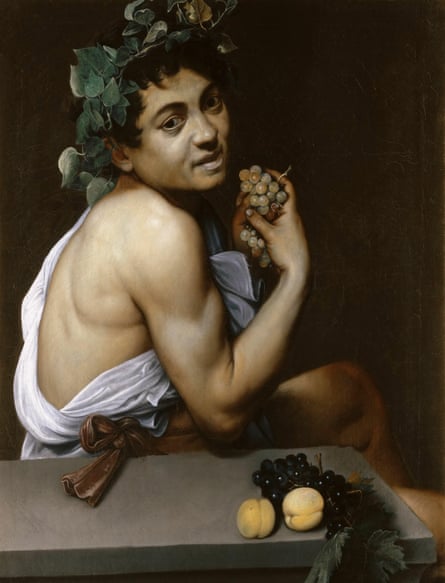
Hardly any of Caravaggio’s recorded words have survived. His statements in court during his frequent trials on charges of violence, theft or libel have the terseness of a habitual criminal giving nothing away. His paintings, however, tell another story. Soon after arriving in 1590s Rome from Milan, where he was trained, he painted himself posing as the wine god Bacchus. It’s a disarming, intentionally troubling self-portrait. He sits bare-backed by a low table clutching a bunch of shiny moist green grapes: far from being nourished by these sweets, his young body and face are a sickly colour, his features wizened. At the age of about 22 he shows himself addicted to pleasure and prematurely aged, a Bacchanalian reveller at death’s door.
It’s an image of the artist as outlaw, painted over 250 years before Baudelaire popularised the modern idea of artistic outsiderdom. Caravaggio’s face appears regularly after this in his art. In the huge painting of The Martyrdom of Saint Matthew that made him a star of religious painting in the born-again Rome of the early 1600s, he stares with anguished horror at Matthew who’s about to be killed by a near-naked young man stood over him, sword in hand. Yet Caravaggio’s wild ways were soon to derail his life. In 1606 he got into a fight over a game of tennis and killed his opponent Ranuccio Tomassoni. He had to flee Rome. He headed south.
Caravaggio’s art changed profoundly after he killed Ranuccio. There were no more grapes. Even in one of the most intensely Christian canvases he’d painted before the murder, The Supper at Emmaus, he finds room for a brilliant still life of a basket of fruit. Such joyous details vanished from Caravaggio’s art when he was on the run; his brushwork became harsher, more expressive, in a reduced, stark palette. On his first visit to Naples he painted The Seven Works of Mercy, an almost monochrome nocturnal scene set in the city’s mean streets where people perform humble acts of goodness. This painting is new in mood: it is fervent, humble. The intensity of this plea for decency and kindness shows Caravaggio was completely sincere when he sailed for Malta in July 1607 planning to join the Order of St John.
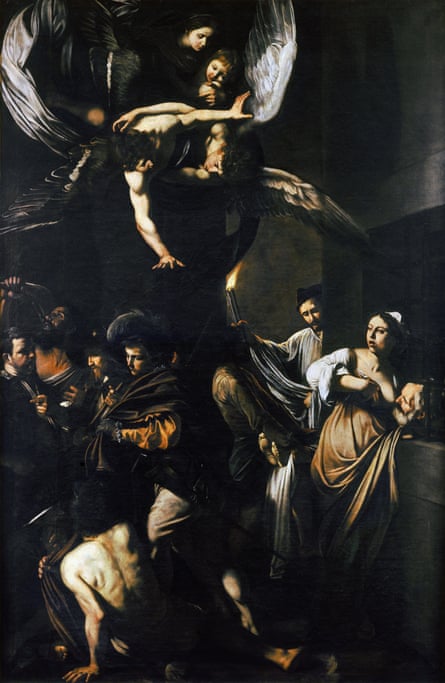
The Order’s capital Valletta is still a daunting fortress with massive stone bastions. Inside this well-defended city were the luxurious lodges where knights from different countries lived. This was an elite international order and Caravaggio was going up in the world. He signed himself “F Michelangelo” on his painting of The Beheading of John the Baptist. The F is for Fra, Brother. He is a new, cleansed man, he asserts: Brother Michelangelo the Christian soldier.
The works he did for the Knights of St John and then on the run from them are perhaps his greatest. The Beheading of John the Baptist is an eyewitness depiction of an atrocity. It takes us into the courtyard of a prison. Inmates watch from behind bars, getting a glimpse of their own likely fate. An executioner reaches behind his back for his knife. He has already decapitated the grey-faced John with a sword, but not completely. There’s a flap of skin and flesh to sever before the head is fully off.
This is what violence is really like, shows Caravaggio – it’s never neat and never ends. He knows, for he saw this, the signature tells us; he seems to have stuck his brush or a stick or even his finger in the blood that flows from John’s head, using it to trace his name on the ground, implying he was on the spot as an eyewitness.
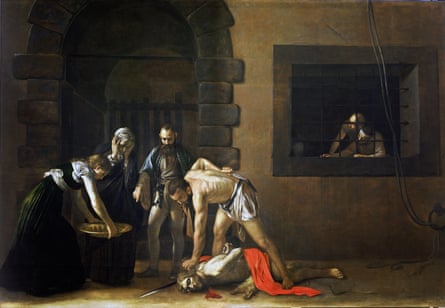
Yet for all his new idealism, Caravaggio’s art on Malta shows him straining at the leash of the Knights’ moral code. The Order was supposedly celibate. Yet sexuality has a way of insinuating itself into his paintings. In his portrait of the Grand Master Alof de Wignacourt, the Christian knight stands nobly in the bronze evening light. But there’s an undercutting detail: while Wignacourt looks past us into the twilight of chivalry, his page provocatively catches Caravaggio’s eye.
after newsletter promotion
It’s hard to see this look as non-sexual when you are familiar with Caravaggio’s early paintings of male sex workers proffering fruit or his depictions of Cecco, “his boy that lay with him”, as a 17th-century source has it.
It was however for fighting, not sex, that Caravaggio was abruptly arrested and thrown into the Knights’ prison. He managed to escape and sailed to Syracuse in Sicily. There he is credited with naming a spectacular tall cave the Ear of Dionysius after the tyrant who ruled this ancient Greek city and used it as a natural amplifier to eavesdrop on prisoners. It’s a telling image of Caravaggio’s unease, his apparently well-founded fear that he was being followed.
He was hounded by inner as well as outer torments. In Syracuse he painted The Burial of Saint Lucy, showing the obsequies of the city’s patron saint. The body of Lucy lies by an open grave which two burly gravediggers are finishing as the people of Syracuse gather in an underground chamber. It is moving but macabre too. Caravaggio has become as drawn to death as he once was to grapes and boys. Moving on through Sicily to Messina, he painted a Raising of Lazarus that takes religious art into the realms of horror. Christ raises his arm to reanimate the corpse of Lazarus. It jerks into life in a way that is as frightening as it is miraculous. And then after fleeing via Palermo to Naples he paints the martyrdom of Saint Ursula.
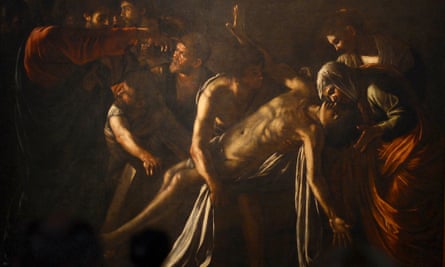
So what exactly happened at the tavern in Naples? The facial disfigurement Caravaggio suffered sounds very much like the ritual punishment known as sfregio. This formalised slashing of someone’s face was, in 1600s Italy, a brutal marker of sexual disgrace. It was most commonly inflicted by men on female sex workers, but wives and girlfriends could also be targets. Its most famous perpetrator is probably the sculptor Gianlorenzo Bernini who arranged for his “beloved” Costanza Bonarelli, by whom he felt betrayed, to be cut on the face in this way – despite portraying her in one of the most intimate sculptures ever made.
Was Caravaggio being similarly branded by the Knights of St John for a sexual crime or scandal, the public shame cut in blood into his face? I think it’s possible and the evidence is there in his work. That look between him and Wignacourt’s page may have been more than a painterly provocation. Or perhaps it was de Wignacourt to whom he had got too close. Caravaggio painted the Grand Master bare-chested as St Jerome in an unmanning work that is tenderly loving of the older man’s wiry frame as he sits writing in what could be a bedroom. Perhaps the faith Wignacourt placed in Caravaggio, only to have it abused, was motivated by fierce personal emotions, even love.
Humiliated and scarred for life by the attack in Naples, Caravaggio finally received news of his pardon for the murder of Ranuccio. He only had to get back to Rome to receive the Pope’s benediction. Everything was going to be all right. Except he plainly didn’t believe that. In The Martyrdom of Saint Ursula the saint contemplates the arrow, bemused yet accepting. She passively endures her death.
Caravaggio’s last painting is a suicide note. He’s not going to get pardoned. The boat is waiting and one way or another he’s nearly at the end of his journey.
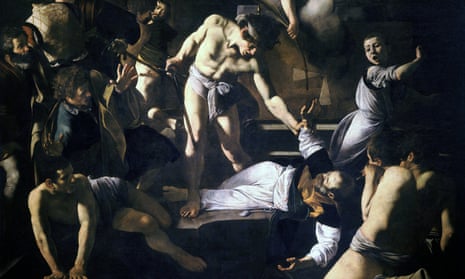
Comments (…)
Sign in or create your Guardian account to join the discussion